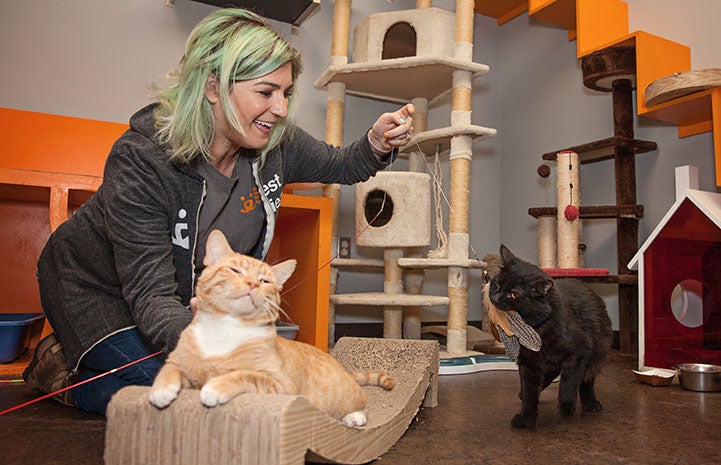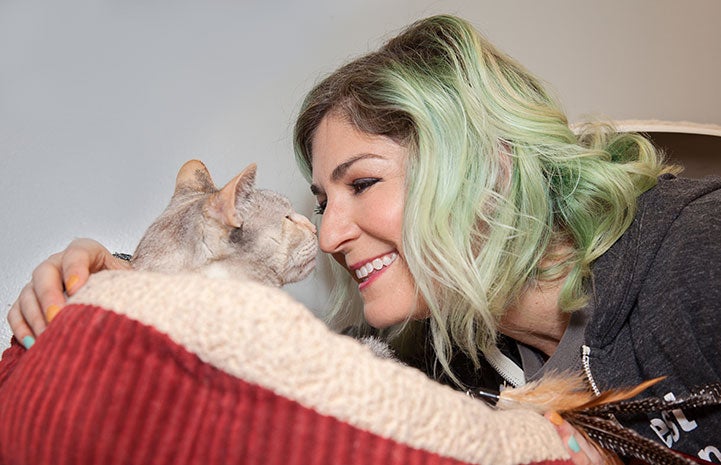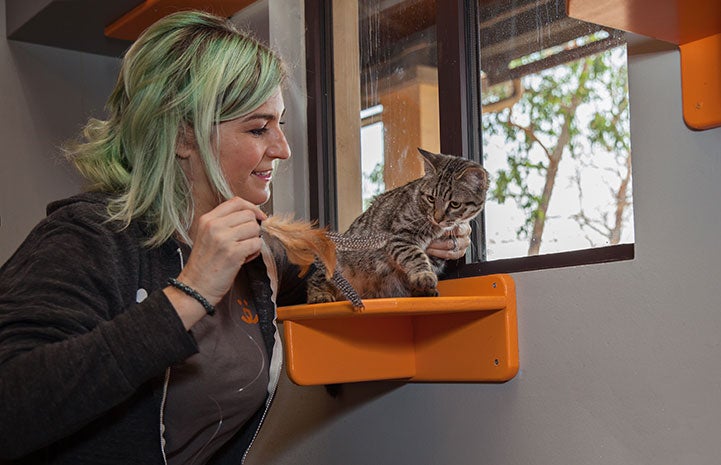Cat questions and answers: Learn from the experts

When shelter cats arrive at the Best Friends Pet Adoption and Spay/Neuter Center in Los Angeles, some are shy, nervous and scared — but usually not for long. That’s because staff and volunteers are available to help those cats feel better so potential adopters can see their true personalities (whether sassy or sweet), and so they can find their ideal forever homes.
Of course, the cat behavior and enrichment program not only helps cats feel more comfortable while they’re at the center, it brings us closer to our goal of making Los Angeles a no-kill city by the end of 2017. And the cats, who come to the center from Los Angeles Animal Services, get a second chance at a finding a happy home. Some just need extra help to get there.
Cat behavior and enrichment
Samantha Bell DiGenova, cat behavior and enrichment program lead, makes sure every cat has a chance to heal from past emotional trauma, as well as feel safe, calm and secure. Every day at the center, her team uses the latest research while working behind the scenes to help even the most behaviorally challenged cats, so that they can find loving homes. In turn, the program creates more space and lifesaving opportunities for even more homeless cats.
In the following Q-and-A, Samantha shares what she’s learned from cats over the years, including common misconceptions and how to help exceptionally frightened cats. She also describes the lifesaving work her team is doing and provides some tips on how to help a behaviorally challenged cat (maybe even your own).

Q: When cats first arrive at the center, they are often very scared. How do you help them relax so potential adopters can get to know them better?
A: I make it a point to visit the new arrivals within an hour of when they are put in their kennels. I bring three things to every new cat: treats, toys and a calming pheromone spray. I want them to understand that this new place is safe, and that they have friends here. If they realize that nice things come from those who visit their kennels, they will be more likely to interact with potential adopters.
Q: Based on your work as the cat behavior and enrichment program lead at Best Friends–Los Angeles, what would you say are the biggest misconceptions people have about cats?
A: People just want to pet and hug them all day, but that’s not necessarily what cats want. If people provided their cats with daily opportunities to do what comes naturally to them, we wouldn't see as many behavior issues, and we wouldn't see as many cats in shelters.
Another misconception I hear often is that male cats are undesirable because they are territorial, they don't get along with other male cats and they spray in the home. This is not an accurate stereotype for neutered male cats. I have three males at home who adore each other, welcome both male and female foster cats into their home, and have never sprayed. I have found male cats to be extremely affectionate and easygoing!

Q: When dealing with behaviorally challenged cats, especially those who bite and scratch, how to you help them to become friendlier and less aggressive?
A: Cats are both predators and prey, which is unique because most animals are either one or the other. Predators bite, scratch and kill things, while prey are on the receiving end of these actions. All cats feel more confident and less stressed when they feel like a predator and are doing the biting, scratching and "killing."
If we give cats opportunities to hunt and bite toys that look and move like their prey, they can bite and scratch them versus other moving objects (like us). I get out wand toys and give the behaviorally challenged cats opportunities to feel like a predator. This builds their confidence, reduces their stress and gets the biting out of their system.
Get involved. Become a member of Best Friends.
Q: Cats are often depicted as independent and self-reliant. How important is it for cats to get affection and socialize with others? How do they get to do this at the center?
A: Because cats are not as dependent upon us for approval as dogs typically are, they are often seen as aloof. But cats actually thrive on social interaction with people, and even with other cats. Our fantastic volunteers ensure that our cats experience daily positive interactions with people. They keep the cats feeling social and friendly, which helps them to find homes.
As for socializing with other cats, we let the cats decide if this is something they want. All the cats get their own kennel upon arrival. They can adjust at their own speed, and our vets can ensure they are healthy before introducing them to other cats. Once we know they are healthy and ready, they move to a room on the adoption floor where they have their own kennel, but can also jump out and explore the room.
While they explore, we assess their reaction to the other cats in the kennels around them. If they are completely terrified of the other cats, they move to a spot on the adoption floor where they won't have to interact with other cats. If they do well, but aren't totally confident around other cats, we leave them in this room until they're adopted. If they want to interact with other cats, we move them to a free roam room where they can enjoy the company of other cats until they are adopted. It's all up to them. If they feel comfortable where they're living, they will show well to potential adopters.
Give them a chance. Sponsor a Best Friends animal.
Q: You spend most days helping and teaching cats, but what do they teach you? What are some of the biggest lessons you've learned from them?
A: I have always been equally a teacher and a student at heart. I taught first grade for many years and learned so much from the children I taught. Now I'm able to teach cats, as well as staff and volunteers, and continue learning from all of them every day. I think the most important things the cats have taught me are patience and altruism. It is all about the cats and meeting their needs, not mine. I may want to work with a certain cat at a certain time, but if the cat is not in the mood, I have to suck it up and move on. Allowing the cats to call the shots will help them feel confident and realize that they are safe. It's all about them!
Help us Save Them All. Donate today.
Photos by Lori Fusaro
